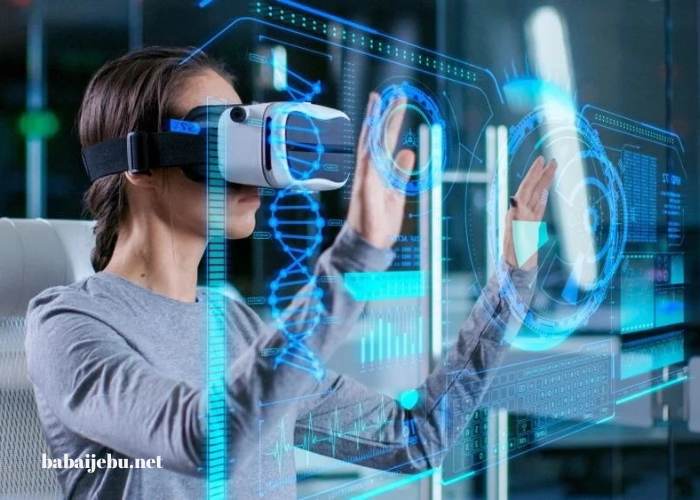In the ever-evolving landscape of technology, Augmented Reality (AR) emerges as a transformative force, heralding a new era in user interaction. Unlike Virtual Reality (VR), which immerses users in entirely fabricated environments, AR overlays digital content onto the real world, blending virtual elements seamlessly with the physical environment. This innovative approach opens up unprecedented possibilities for both consumers and businesses, making AR the next frontier in user interaction.
Defining Augmented Reality
Augmented Reality refers to the integration of digital information with the user’s environment in real time. Unlike VR, which creates an entirely synthetic world, AR enhances the real world by adding layers of digital data—images, sounds, or other sensory stimuli—overlaid on the physical space. This blending of the digital and physical worlds allows users to interact with virtual elements as though they were part of their real-world surroundings.
The technology behind AR involves complex algorithms, computer vision, and advanced sensors. AR systems use cameras and sensors to capture the physical environment, analyze the scene, and then render virtual objects or information onto the live feed. This process requires high precision to ensure that the digital content aligns correctly with the real-world context, providing a coherent and immersive experience.
Applications Across Industries
The potential applications of AR are vast and varied, spanning numerous industries and sectors. In retail, AR enhances the shopping experience by allowing customers to virtually try on clothes or visualize how furniture will look in their homes before making a purchase. Brands like IKEA have pioneered this application with their AR apps that let users see how different furniture pieces fit into their living spaces.
In healthcare, AR is revolutionizing medical training and patient care. Surgeons use AR to overlay critical information, such as anatomical data, onto a patient’s body during operations, improving precision and outcomes. Medical students benefit from AR simulations that offer interactive learning experiences, bridging the gap between theoretical knowledge and practical skills.
The education sector also benefits from AR’s immersive capabilities. Educational tools and applications use AR to bring complex subjects to life, making learning more engaging and interactive. For instance, AR can turn a standard textbook into an interactive 3D model, allowing students to explore historical sites, scientific phenomena, or artistic masterpieces in a more dynamic and memorable way.
Enhancing Entertainment and Gaming
The entertainment and gaming industries have been early adopters of AR technology, with applications that range from interactive storytelling to immersive gaming experiences. Pokémon GO, a landmark AR game, achieved global success by encouraging players to explore their real-world surroundings to capture virtual creatures. This blend of physical activity and digital interaction exemplifies AR’s potential to create engaging and novel experiences.
Moreover, AR enhances live performances and events by integrating digital effects into concerts, sports, and theater. Artists and performers can use AR to create visually stunning experiences that captivate audiences and offer new forms of storytelling and engagement.
Challenges and Future Directions
Despite its promising potential, AR technology faces several challenges. One major concern is ensuring seamless and accurate integration of digital content with the real world. Issues such as latency, tracking accuracy, and field-of-view limitations need to be addressed to enhance the overall user experience.
Privacy and data security are also critical considerations. AR devices often collect vast amounts of data about users’ environments and interactions. Ensuring that this data is handled securely and transparently is essential to maintaining user trust and protecting personal information.
The development of more advanced AR hardware is necessary to fully realize its potential. Current AR devices, such as smart glasses, are often bulky and limited in functionality. Future advancements will likely focus on creating more compact, lightweight, and comfortable devices with improved processing power and battery life.
The Road Ahead
As AR technology continues to evolve, its integration into everyday life is expected to deepen. Advances in artificial intelligence (AI) and machine learning will enhance AR’s ability to understand and interact with the environment, making virtual elements more contextually relevant and responsive.
In the business world, AR is set to revolutionize customer service and support. Companies can use AR to provide remote assistance, allowing technicians to guide users through complex tasks or troubleshoot issues in real time. This application not only improves efficiency but also reduces the need for on-site visits, saving time and costs.
Moreover, the convergence of AR with other emerging technologies, such as 5G and the Internet of Things (IoT), will further expand its capabilities. The high-speed, low-latency connectivity of 5G networks will enable more fluid and responsive AR experiences, while IoT devices will allow AR applications to interact with a wide range of smart objects and sensors.
Conclusion
Augmented Reality stands at the forefront of a new era in user interaction, bridging the gap between the digital and physical worlds. Its potential to transform industries—from retail and healthcare to education and entertainment—is immense, offering innovative ways to engage with information and experiences. As AR technology advances and becomes more integrated into daily life, it promises to redefine how we interact with the world around us, making it an exciting field to watch and explore.
In summary, AR represents not just a technological advancement but a paradigm shift in user interaction. Its ability to overlay digital content onto the real world enhances our understanding and engagement with our environment, paving the way for a more interactive, immersive, and connected future. As we continue to explore and develop AR technology, its impact on society and industry will undoubtedly be profound, marking a new frontier in the way we experience and interact with the world.




